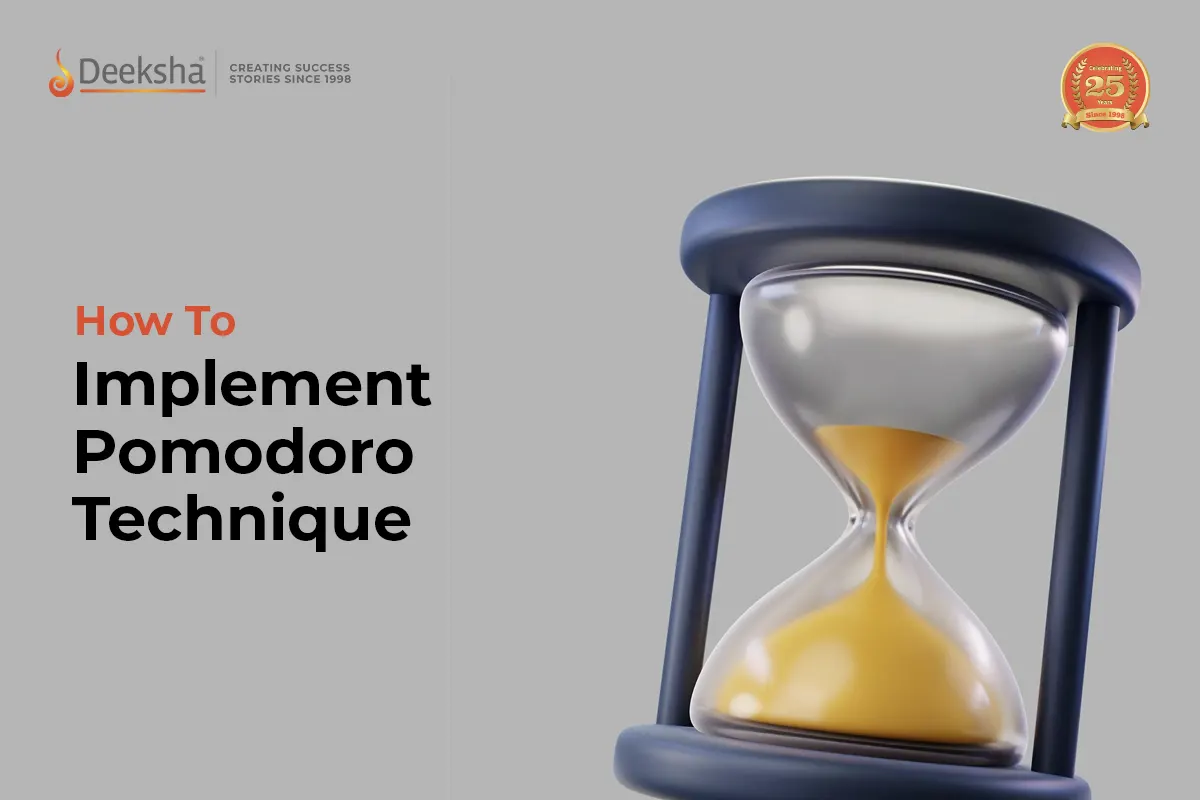In today’s fast-paced academic environment, finding an effective study method is crucial for success. One strategy stands out for its simplicity and effectiveness: the Pomodoro Technique. Originating from the innovative mind of Francesco Cirillo in the late 1980s, this time management method has garnered widespread acclaim for enhancing focus and productivity. By breaking down study sessions into short, concentrated intervals — traditionally 25 minutes in length, followed by a 5-minute break — it offers a pragmatic approach to tackling academic challenges.
For students navigating the rigorous pre-university (PU) coursework, and parents seeking to support their academic endeavors, integrating the Pomodoro Technique with Deeksha Learning’s comprehensive coaching could be a game-changer. Deeksha’s holistic approach, tailored for science and commerce streams, prepares students for not just PU exams but also for competitive tests such as JEE, NEET, and KCET. By combining Deeksha’s expert guidance with the Pomodoro Technique, students can enhance their study efficiency, manage time effectively, and ultimately achieve their educational goals with less stress and more success.
Whether opting for traditional Pomodoro timer devices, exploring online Pomodoro timers, or utilizing a Pomodoro technique app for scheduling study sessions, this method’s flexibility and simplicity make it an invaluable tool for every student’s arsenal. In this article you will discover how the Pomodoro Technique can revolutionize study habits and complement Deeksha Learning’s integrated coaching approach, paving the way for academic excellence and exam preparation mastery.
Understanding the Pomodoro Technique
In the late 1980s, a university student named Francesco Cirillo found himself struggling with the same issue that plagues many students: time management. In his search for a solution, Cirillo developed what would become one of the most acclaimed study methods worldwide—the Pomodoro Technique. Named after the Italian word for “tomato,” inspired by the tomato-shaped kitchen timer Cirillo used to track his work, this method has transcended its humble beginnings to become a cornerstone of productive study sessions and effective time management.
At its core, the Pomodoro Technique is beautifully simple. It involves breaking down work into intervals, traditionally 25 minutes in length, separated by short breaks. These intervals, known as “Pomodoros,” are dedicated to focused study or work, free from all distractions. After each Pomodoro, a brief rest period of about 5 minutes allows for mental recovery, followed by another focused session. After four Pomodoros, a longer break is recommended, aiding in cognitive recovery and preventing burnout.
The science behind this technique is rooted in cognitive behavioral theory, suggesting that the human brain functions more efficiently in short, focused bursts. It leverages the concept of ‘distributed practice,’ which has been shown to improve memory retention and learning outcomes significantly. By dividing study sessions into manageable chunks, the Pomodoro Technique ensures that information is not only absorbed more efficiently but also retained more effectively over time. This method combats procrastination by making tasks appear more manageable and provides a clear structure to study sessions, which is particularly beneficial for exam preparation.
Moreover, the regular breaks mandated by the Pomodoro Technique serve a dual purpose. They help maintain a high level of concentration during study sessions and facilitate a better understanding and retention of material. This method has been especially beneficial for students preparing for high-stakes exams, where efficient time management and information recall are paramount.
The Pomodoro Technique’s history, rooted in a student’s desire to improve their study habits, underscores its value and relevance to students worldwide. As learners grapple with the demands of coursework and exam preparation, adopting this method can lead to significant improvements in time management, focus, and ultimately, academic performance.
Benefits of Pomodoro Technique for Students
The Pomodoro Technique, with its structured intervals of focused study time followed by short breaks, offers numerous benefits that can significantly enhance a student’s academic journey. This method is particularly advantageous for students at Deeksha Learning, who are navigating the demanding curriculum of pre-university courses and the rigorous preparation required for competitive exams like JEE, NEET, and KCET.
- Improved Concentration and Focus: One of the most immediate benefits of the Pomodoro Technique is the substantial improvement in students’ ability to concentrate. By dedicating short, manageable segments of time to study, with the promise of a break at the end, students are more likely to maintain focus throughout the session. This method helps in minimizing distractions, as the knowledge that there’s a break coming up encourages students to make the most of their focused study time.
- Reduced Study Stress: The pressure of preparing for competitive exams can be overwhelming for many students. The Pomodoro Technique alleviates this stress by breaking down the study material into smaller, more manageable parts. Knowing that they only need to focus for a set period before taking a break makes the task seem less daunting and more achievable. This approach can significantly reduce anxiety levels and create a more positive and productive study environment.
- Enhanced Productivity: By maximizing focus and minimizing distractions, students can significantly enhance their productivity. The Pomodoro Technique ensures that time is used efficiently, allowing students to cover more material in less time. This efficiency is crucial when preparing for competitive exams, where the breadth of the syllabus can be vast and time is of the essence.
- Improved Time Management: Effective time management is a critical skill for academic and personal success. The Pomodoro Technique teaches students to work with time, instead of against it, fostering a greater awareness of how they use their study hours. This method encourages students to plan their study sessions more effectively, allocating time for different subjects and topics, ensuring a more balanced and comprehensive exam preparation.
- Deeksha Learning Benefits: For students at Deeksha Learning, integrating the Pomodoro Technique into their study regimen can complement the holistic coaching approach. Testimonials from students who have adopted this method highlight its effectiveness in enhancing focus, reducing exam preparation stress, and improving time management skills. By incorporating the Pomodoro Technique, Deeksha students have reported better academic outcomes, demonstrating the method’s role in facilitating a more efficient and productive learning experience.
In essence, the Pomodoro Technique serves as a powerful tool in a student’s arsenal, particularly for those preparing for high-stakes exams. Its benefits extend beyond improved academic performance, fostering skills like concentration, time management, and stress reduction, which are invaluable throughout one’s educational journey and beyond.
Step-by-Step Guide to Implementing the Pomodoro Technique
Implementing the Pomodoro Technique into your study routine can significantly enhance your focus, productivity, and overall academic performance, especially when preparing for competitive exams. Here’s a detailed guide to get you started, incorporating specific steps that align with Deeksha’s study schedules for a seamless integration of this effective time management method.
Step-by-Step Guide to Implementing the Pomodoro Technique
- Understanding the Basics: First, familiarize yourself with the core principles of the Pomodoro Technique—25 minutes of focused study followed by a 5-minute break. After four cycles, take a longer break of 15 to 30 minutes.
- Creating a Distraction-Free Study Environment: Set up a study space where distractions are minimized. This means having a clean, organized desk, turning off unnecessary electronic devices, and informing others that you’re in a focused study session to avoid interruptions.
- Choosing the Right Pomodoro Timer: Select a Pomodoro timer that works best for you. This could be a physical kitchen timer, a Pomodoro timer online, or a Pomodoro technique app. The key is to have a timer that is easily accessible and simple to use without any further distractions.
- Planning Your Study Sessions: Before starting, outline what you aim to accomplish during each Pomodoro session. Break down your study schedule into topics or subjects that fit into 25-minute segments, ensuring a clear focus for each session.
- Starting Your First Pomodoro: With your study plan and timer set, begin your first 25-minute study session. Focus solely on the task at hand until the timer rings. Then, mark one Pomodoro complete and take a 5-minute break.
- Taking Productive Breaks: During your breaks, step away from your study space. Engage in activities that help you relax and recharge, like stretching, grabbing a snack, or taking a brief walk.
- Reviewing and Adjusting: After each set of four Pomodoros, take a longer break. Use this time to review what you’ve learned and adjust your study plan as needed for the next cycles.
- Integrating with Deeksha’s Study Schedule:Align your Pomodoro sessions with the Deeksha study schedule, dedicating Pomodoros to specific subjects or areas of focus as per your exam preparation needs. This will ensure a comprehensive and efficient study plan tailored to competitive exams.
Beginner’s Table for Pomodoro Technique Integration
To ease into the habit of using the Pomodoro Technique, here’s a sample table beginners can follow. Adjust it based on your specific study needs and schedule.
| Day | Task | Pomodoros Allocated | Break Activities |
| Monday | Math Problems | 4 Pomodoros | Stretch, Short Walk |
| Tuesday | Physics Concepts | 4 Pomodoros | Snack, Quick Chat |
| Wednesday | Chemistry Revision | 4 Pomodoros | Listen to Music, Relax |
| Thursday | Sample Papers | 4 Pomodoros | Meditation, Breathing Exercises |
| Friday | Biology Diagrams | 4 Pomodoros | Tea Break, Stretching |
| Saturday | Review Week’s Study | 6 Pomodoros | Longer Walk, Leisure Reading |
| Sunday | Rest/Leisure Time | – | – |
This table is a starting point; customize it to fit your study priorities and personal preferences. Remember, consistency is key to making the Pomodoro Technique a beneficial part of your study routine, leading to improved focus, reduced stress, and better time management—crucial components for success in competitive exams.
Pomodoro Technique Tips and Tricks
Mastering the Pomodoro Technique can transform your study sessions, making them more productive and less stressful. As you become accustomed to this method, there are several tips and tricks you can use to further enhance its effectiveness, especially when preparing for competitive exams through Deeksha’s curriculum. Here are some advanced strategies to maximize the benefits of the Pomodoro Technique:
- Customize the Duration: While the traditional Pomodoro lasts 25 minutes, don’t hesitate to adjust this based on the task at hand or your concentration span. For tasks requiring deeper focus, consider extending Pomodoros to 50 minutes, followed by a 10-minute break. This can be particularly useful for complex subjects requiring prolonged concentration.
- Tailor the Technique for Different Subjects: Different subjects may require different approaches. For instance, subjects requiring memorization might benefit from shorter Pomodoros to frequently review material, whereas problem-solving subjects like Mathematics might require longer, uninterrupted study periods.
- Use Technology Wisely: Leverage apps and tools designed for the Pomodoro Technique. These can help track your progress, remind you to take breaks, and even block distracting websites during focus periods.
- Integrate with Deeksha’s Strategies: Align the Pomodoro Technique with Deeksha Learning’s study strategies. Use Pomodoros to break down Deeksha’s study materials and mock tests into manageable chunks, ensuring comprehensive coverage of syllabus and practice material.
- Plan for Longer Study Sessions: During exam time, when longer study sessions become necessary, divide your day into several “Pomodoro Blocks” with specific goals for each block. This helps maintain a high level of productivity without burnout.
By tailoring the Pomodoro Technique to fit your individual study needs and integrating it with Deeksha’s structured strategies, you can create a powerful, personalized approach to exam preparation. This approach not only enhances your study efficiency but also significantly contributes to exam success.
FAQs on the Pomodoro Technique
What are the five steps of the Pomodoro Technique?
- The Pomodoro Technique involves five key steps: 1) Choose a task. 2) Set the Pomodoro timer (traditionally for 25 minutes). 3) Work on the task until the timer rings. 4) Take a short break (5 minutes). 5) After four Pomodoros, take a longer break (15-30 minutes). This cycle helps improve focus and enhances productivity during study sessions.
How do you use the Pomodoro Technique in meetings?
- To apply the Pomodoro Technique in meetings, break the meeting into 25-minute segments with short breaks in between. This ensures discussions remain focused and time-efficient. It’s particularly useful for brainstorming sessions or workshops, keeping participants engaged and productive.
What is the best time for a Pomodoro?
- The best time for a Pomodoro session is during periods of high energy and low distraction. This varies among individuals, but mornings are often ideal for many. Identify when you’re most alert and use that time for tasks requiring deep focus.
Does the Pomodoro technique actually work?
- Yes, the Pomodoro Technique works for many by breaking down work into manageable intervals, reducing burnout, and increasing productivity. It’s particularly effective for students and professionals looking to enhance their time management and study habits.
How many Pomodoros can you do in a day?
- The number of Pomodoros one can do in a day varies, but aiming for 16 to 20 Pomodoros allows for significant work with ample breaks. Listen to your body and mind to avoid burnout.
Who should use Pomodoro?
- Anyone looking to improve their time management, concentration, and productivity can benefit from the Pomodoro Technique. It’s especially beneficial for students, professionals, and anyone preparing for exams or large projects.
Why is it called Pomodoro?
It’s called Pomodoro after the Italian word for tomato because Francesco Cirillo used a tomato-shaped kitchen timer to track his work sessions while developing the technique.
What is the 52 17 rule vs Pomodoro?
The 52 17 rule suggests working for 52 minutes and breaking for 17, contrasting with the shorter cycles of the Pomodoro Technique. Both aim to optimize focus and rest but cater to different concentration spans.
What are the benefits of the Pomodoro Technique?
Benefits include improved focus, enhanced productivity, reduced anxiety, better time management, and increased satisfaction with work.
What not to do during a Pomodoro break?
Avoid engaging in tasks that require deep concentration or could extend beyond the break period. Stick to activities that relax your mind.
What is better than the Pomodoro Technique?
No single method suits everyone. Alternatives like the 52/17 rule or time blocking may work better for different concentration spans and tasks.
Is Pomodoro good or bad?
The Pomodoro Technique is highly beneficial for many, though its effectiveness can vary based on individual preferences and the nature of the work.
What are the criticisms of the Pomodoro Technique?
Critics argue that it may not suit tasks requiring prolonged, uninterrupted focus or those who prefer a more flexible approach to time management.
What is the problem with Pomodoro?
Some find the strict time limits restrictive or challenging to adhere to, particularly for complex tasks that require longer, undisturbed focus.
Can I skip Pomodoro breaks?
Skipping breaks can lead to burnout and reduce overall productivity. Breaks are integral to the technique’s effectiveness.
Can I read during Pomodoro breaks?
Light reading is fine, but avoid dense or study-related material to give your brain a rest and maximize the benefit of your break.
Final Thoughts
Mastering the Pomodoro Technique can mark the beginning of a transformative journey in your academic pursuits. Its structured approach to time management and study sessions aligns perfectly with the rigorous, results-oriented coaching provided by Deeksha Learning. By adopting this method, students gain an invaluable tool for enhancing concentration, productivity, and ultimately, exam performance. The synergy between the Pomodoro Technique and Deeksha’s comprehensive methodology paves the way for students to not just meet but exceed their academic goals, ensuring they are well-prepared for the challenges of PU and competitive exams.
We encourage students, especially those in the 10th grade looking forward to excelling in their careers through PU and competitive exams, to embrace this effective study technique. To learn more about how Deeksha’s programs can be tailored to fit your individual needs and how the Pomodoro Technique can be integrated into your study plan, reach out to our student counselors. Let us guide you towards academic success and help you achieve your dreams. Take the first step towards mastering your studies and your future today.
Table of Contents















Get Social